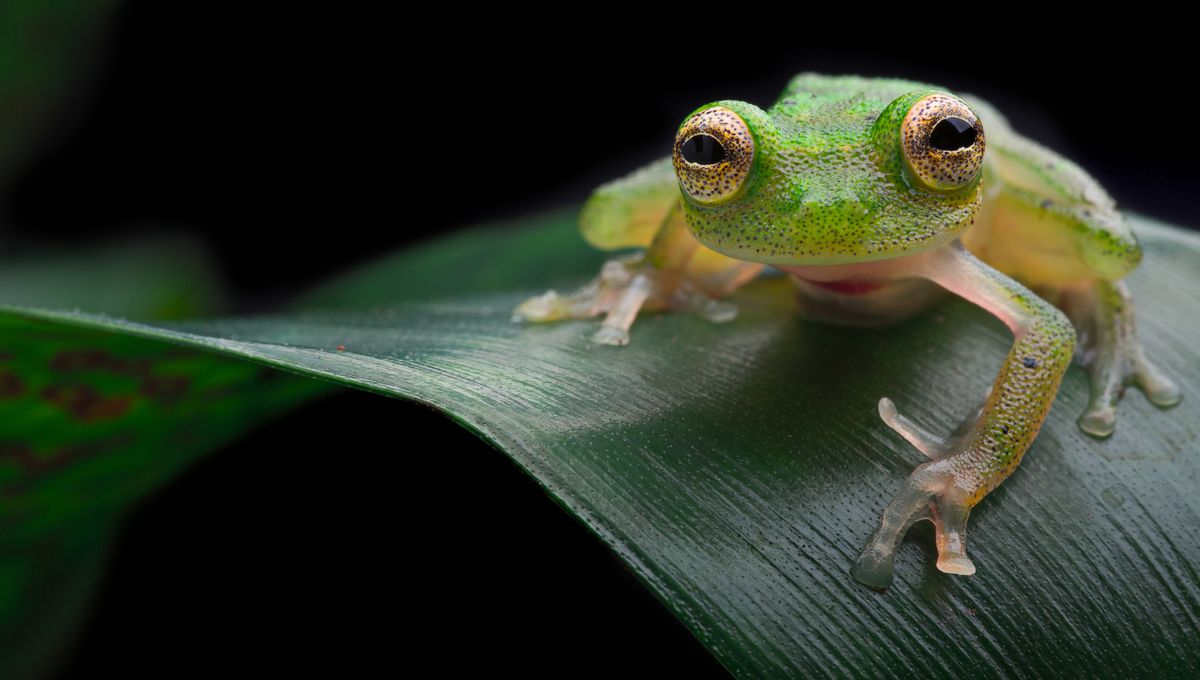
Important information for anyone kissing frogs in search of a prince – if you’re hoping to start a family, measure the testicles first. The bigger the balls a glass frog is carrying, the less chance it will make a good father. The finding is consistent with evolutionary models, and for that matter, with evidence from some other species, but the pattern is not universal.
Along with survival of the fittest, evolution is driven by sexual selection, among other processes. The animal kingdom has found a lot of different ways for this to operate, usually – although not always – among males.
In some species, males woo females with bright colors or dances, in others they fight for dominance. Then there are the species where sperm competition is key to passing on one’s genes, usually identifiable by the size of the cojones. This has now been verified in neotropical glass frogs, with the findings appropriately published on Valentine’s Day. But there’s a price to pay for all that testicular endowment, and it comes when it’s time to raise the young.
Many Centrolenidae, popularly known as glass frogs for their transparent abdominal skin, live in the tropical rainforests of Central and South America, when not presenting The Muppet Show. The females lay eggs on leaves hanging over water before moving on to greener ponds. The males hop in to fertilize after the female has gone, which means she exercises no choice over the father, and there can be lots of competition over a newly laid clutch.
How this competition plays out varies by species, providing Anyelet Valencia-Aguillar of São Paulo State University and collaborators with an opportunity to explore strategies.
Males of some glass frog species have spines sticking off their upper arms, which they use as weapons to fight over who gets to spread their seed. Others guard the eggs, both from rivals and sources of danger.
Another form of competition – we suggest not reading the next bit while eating – is by maximizing sperm production so that if multiple males all jizz over the same set of eggs, those with the most sperm have the most tadpoles. Naturally, larger testicles are key to winning the sperm wars.
This raises the question of the extent to which frogs manage an all-of-the-above strategy, or if there is a trade-off between approaches. An alternative idea is that growth in testicle size is driven not by competition, but by females producing larger clutch sizes. In this scenario, frogs need big balls simply to be able to handle a whole clutch.
Rainforests lend themselves to species diversification, and glass frogs are no exception. Comparing characteristics of 37 species, the researchers concluded that testes were larger among species that (shall we say) eat, shoot, and leave, than those that stick around to keep the eggs safe.
On the other hand, or upper arm, the authors also expected males with fighting spines would come less equipped down below, but found no statistically significant relationship.
Apparently, fighting capacity only takes you so far in the frog world, and even members of species with arm spines need a backup strategy in the crown jewels. Nor were the males much larger than females among small-balled species, a pattern often seen with other animals such as great apes, where gorillas don’t need to engage in sperm competition, using their size and strength to repel rivals.
“Paternal effort could lead to a decrease in gonadal investment because if a male invests more in clutch guarding, he will have less energy to invest in survival, growth, or gamete production,” the authors note. However, this opens the question of why other strategies like fighting spines don’t show the same correlation.
The authors speculate that testosterone drives both testicle size and fighting capacity, so these can go together, but the hormone is less compatible with parental care. However, this theory has yet to be tested. Alternatively, males that spend time looking after a clutch probably only fertilize one per mating season, rather than needing lots of sperm in the hope of happening upon several.
Certainly, the hypothesis that testicle size was a response to larger clutches failed. Indeed, if anything, the opposite was the case: larger clutches were associated with more parental care but had no relation to testicle size.
Frogs are far from the first type of animal in which such studies have been done. In bats, there is a trade-off between testicle and brain size. Like aircraft, flying species can’t carry too much luggage and a bat with big balls aboard must jettison brain weight to stay airborne. Those who invest in intellect probably live longer, but also may have better strategies for wooing mates.
On the other hand, studies of parental care and testicular size have produced differing results depending on the branch of the animal family tree being explored.
Either way, we definitely think someone should tell Miss Piggy to check under the…whatever it is Muppets have.
The study is published in Proceedings of the Royal Society B.
Source Link: Small Balled Glass Frogs Make Better Fathers